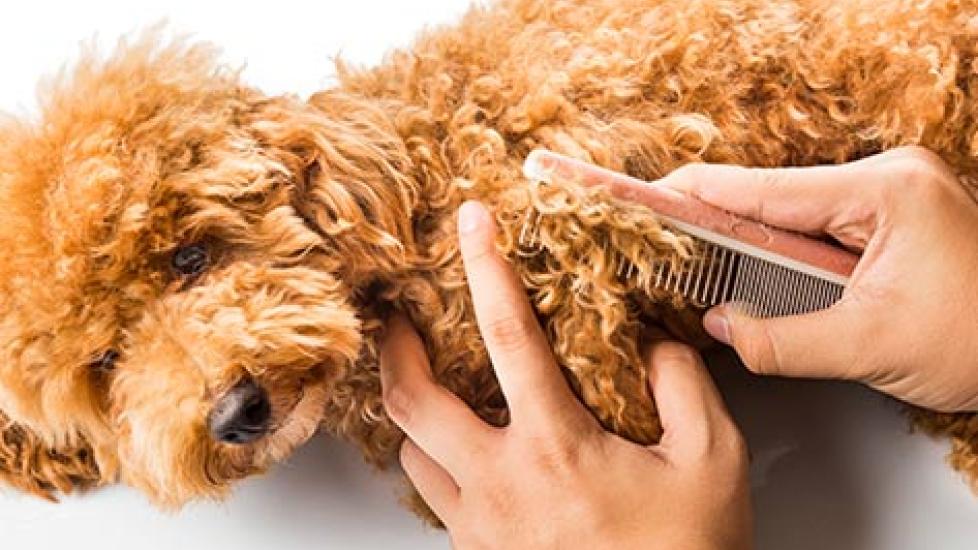Dog’s Hair in Knots? How to Get Them Untangled and Under Control
By Carol McCarthy
As a certified master groomer and president of the Paragon School of Pet Grooming, Melissa Verplank has worked on many beautiful dogs, and more than a few in need of extreme makeovers.
The author of the grooming industry reference guide Notes from the Grooming Table has cleaned up dogs with fur so matted that the only solution was to cut off the entire coat, which falls away in one piece like a pelt, she says. That degree of matting is extreme, but all dogs can get tangles and knots in their fur.
Some dogs are more prone to mats, such as the Poodle, Bichon Frise, Cocker Spaniel, and any dog with a long coat or who is a heavy shedder, Verplank says. A dog’s hair shafts are barbed much like a briar bush, with some more barbed than others. “The more barbs in the hair shaft, the more likely to mat,” says Verplank.
Causes of Matted Hair in Dogs
Mats often occur in areas of friction, such as under the collar, behind the ears, in the armpits, or on the lower legs where the legs rub together or where the dog comes into contact with grass.
Dogs that sit a lot, or are “right-hipped” or “left-hipped” when they sit, will get mats from the fur being compacted in that spot, Verplank adds.
Neglect and lack of grooming also cause tangles and knots.
Preventing Hair Mats: It’s All in the Brush
The best way to deal with mats is to not let your dog get them in the first place.
“Regular brushing is key,” Verplank says, noting that static electricity and dryness can foster tangles. “When you brush, add a little moisture with a spray bottle, just a light mist.”
Technique is also very important. Pet parents should use a slicker brush with wire pins and follow the “line brushing” method with a gentle motion. Verplank describes the process:
- Brush a small section at a time. Push the coat up with your hand to the line of the skin, pat the brush into the hair, and pull away from the dog’s body gently.
- Continue with this method of lifting, patting and gently stroking the brush through the coat a small section at a time. This method allows you to thoroughly brush the coat and find any tangles hidden under the top of the coat.
- Depending on the breed, you will want to brush your dog anywhere from once every couple of weeks to daily.
“Once the dogs get used to that and realize they’re not going to get hurt, it’s very soothing. It’s very gentle and very thorough,” she says.
Verplank also advises bathing your dog regularly, as a clean coat is less likely to knot.
Tools and Products for Preventing Matted Hair
Pet parents can use brushes, combs, clippers, or detangling products. Verplank’s favorite tool is a curved back slicker brush. Soft bristle brushes, which vary in density and structure, can work well, depending on the breed, she says. Also, consider the size of the dog when choosing the brush, using a very small one to properly groom a Maltese, for example.
“Ask your groomer about the type of brush to use and to demonstrate how to brush your dog,” Verplank suggests.
There are de-tanglers and shampoos on the market to deal with mats but no magic potions, she says. While dusting a little cornstarch on a tangle can help, in the end it comes down to elbow grease.
When to Throw in the Brush
The process of removing mats can be laborious, and a dog can put up with only so much. “You’re dealing with the attitude of a 2-year-old. And a 2-year-old will allow you to get only a certain amount of tangles out her hair,” Verplank explains. “It’s a time consuming process to get the dead hair off.”
When it appears your dog has had enough and there’s still a long way to go, it’s time to quit and either take him to a professional or give up on the brushing and de-tangling and simply clip the mat off.
“Humanity before vanity. If it can’t be saved, it just needs to be trimmed off,” says Verplank.
Getting all that matted hair off your dog is important for his health as well as his appearance, she adds. “There can be sores and injuries, bugs—all kinds of things can hide under the [matted] coat.”
*You can connect with Melissa Verplank on her Facebook page.
